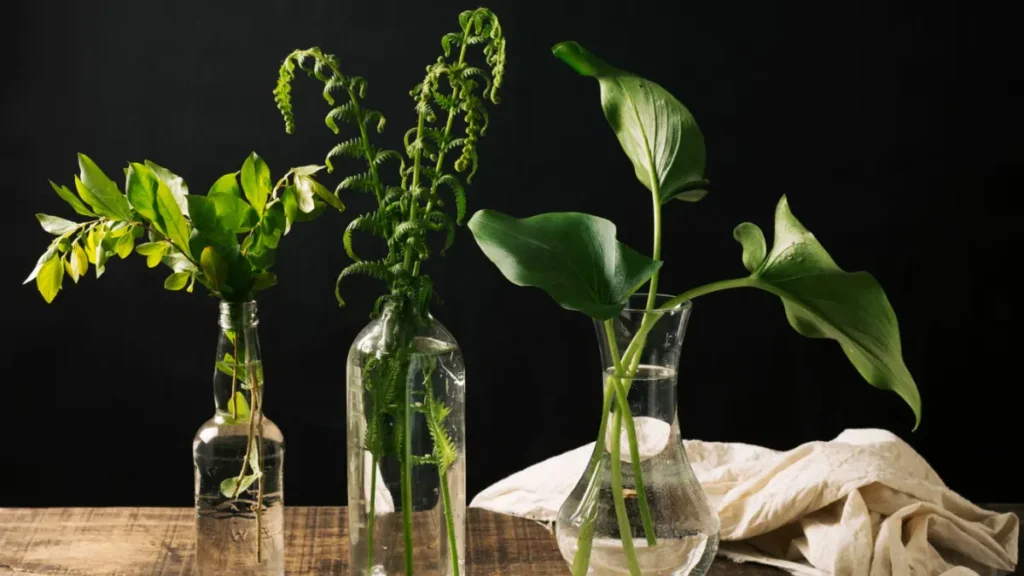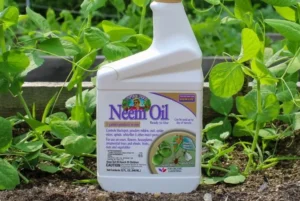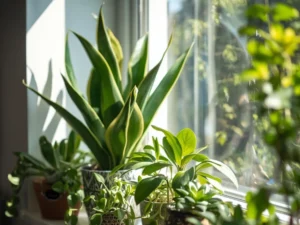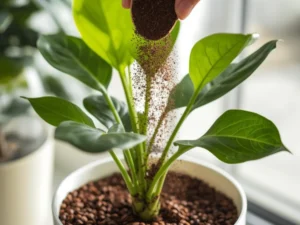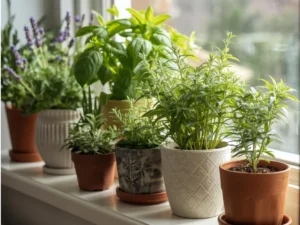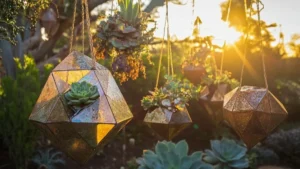Moreover, the 13 Best Plants for Terrariums turn simple glass containers into living art tiny, self-sustaining worlds that bring calm to homes and offices. Furthermore, watching moss creep and ferns unfurl feels grounding, even amid city life. Besides, terrariums aren’t just décor; they’re easy, low-maintenance ecosystems. Therefore, they offer a quiet moment of green that reconnects us with nature every day.
But not every plant thrives behind glass. After years of growing, pruning, and learning from a few wilted experiments, I’ve realised that lasting terrariums depend on choosing species that love humidity, grow slowly, and adapt to shade. So, in this guide, we’ll explore the best plants for terrariums from colourful indoor showpieces to compact vines that quietly thrive under glass.
13 Best Plants for Terrariums: Choosing the Best Plants for Terrariums
Creating a terrarium is part science, part artistry. Once you understand how light, moisture, and airflow shape your mini ecosystem, choosing the right plants becomes intuitive. Some species soak up humidity; others stretch or sprawl to create visual harmony. Below, we’ll break down the best plants for terrariums by category, including care and styling tips.

1. Best Plants for Indoor Terrariums
Indoor terrariums thrive when filled with adaptable, humidity-loving species. Top performers include Fittonia spp. (Nerve Plant), Peperomia rotundifolia (Trailing Jade), Pilea libanensis (Silver Sprinkles), Nephrolepis exaltata (Boston Fern), and Asparagus setaceus (Asparagus Fern).
Care & Maintenance Tips
Keep soil lightly moist, never waterlogged. Use a spray bottle to mist every few days, especially during dry American winters when indoor heat lowers humidity. Trim yellowing leaves monthly to maintain air circulation. If condensation builds up, open the lid briefly to let moisture escape.
13 Best Plants for Terrariums: Styling Ideas
Pair Fittonia’s red-veined foliage with the delicate fronds of Boston Fern for a beautifully textured contrast. Additionally, layer fine gravel or small bark chips at the base because they improve both drainage and visual balance.
In modern American homes, grouping two or three mini terrariums in varying heights looks stunning and creates a natural focal point. Therefore, this simple setup adds elegance and calm without demanding much upkeep.
2. Best Outdoor or Open Terrarium Plants
For open-air designs, the best plants for terrariums include Drosera adelae (Sundew), Nepenthes spp. (Pitcher Plant), Selaginella apoda (Meadow Spike Moss), Ficus pumila (Creeping Fig), and Callisia repens (Turtle Vine). These tolerate airflow and sunlight better than tropical closed-system plants.
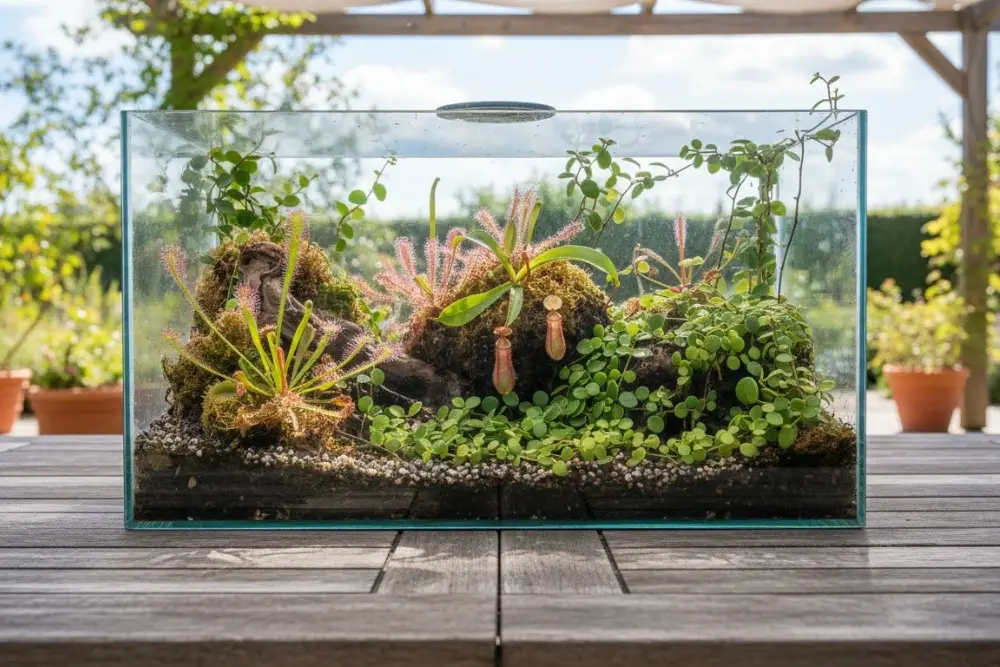
Care & Maintenance Tips for Outdoor Terrariums
Since outdoor setups lose moisture faster, mist the plants daily or whenever soil begins to dry out. Drosera and Nepenthes prefer rainwater or distilled water tap water minerals can harm them. Place your terrarium in partial shade to avoid heat buildup inside the glass, especially during summer months.
Trim Ficus pumila runners to prevent them from overtaking smaller species. If temperatures drop below 50°F, bring your terrarium indoors until it stabilizes.
Styling Open Terrariums
To create a balanced look, mix textures: let Creeping Fig trail around moss-covered rocks while Selaginella apoda fills the gaps with lush greenery. Add natural driftwood, stones, or even small twigs to mimic a woodland feel. Open terrariums look fantastic on outdoor tables like a living centerpiece that changes with the seasons.
3. Best Plants for Height and Structure
Terrariums with vertical interest feel more natural and balanced like tiny forests in glass. Top picks include Asparagus setaceus (Asparagus Fern), Ficus ginseng macrocarpa (Ficus Bonsai), Nephrolepis exaltata (Boston Fern), Peperomia obtusifolia (Baby Rubber Plant), and Pilea peperomioides (Chinese Money Plant).
Care & Maintenance Tips
Provide bright, indirect light and moderate humidity. Mist weekly, keeping soil slightly damp but not soaked. Asparagus setaceus and Ficus ginseng may need pruning every few weeks to maintain height balance. Remove any yellowing fronds quickly to prevent mold in enclosed environments.
Styling Ideas
Use height to guide the eye place Ficus ginseng or Asparagus setaceus toward the back and smaller plants like Fittonia or Baby’s Tears up front. Add a few polished pebbles or moss mounds to create layers. In interiors, tall terrariums look beautiful on console tables or near reading nooks, where their tree-like forms become living sculptures.
4. Best Plants for Colour and Texture
Color makes a terrarium come alive, and texture keeps it visually interesting. Some of the best picks include Begonia rex etna, Begonia blancii, Fittonia spp. (Nerve Plant), Hypoestes phyllostachya (Polka Dot Plant), and Pilea glauca.
Care & Maintenance Tips
Colorful plants are sensitive to extremes. Keep humidity between 60–80% and water gently at the soil base to avoid leaf spotting. Begonias and Fittonia prefer bright, indirect light direct sun that can scorch their delicate foliage. In drier climates like Arizona or Nevada, place a small humidity dish nearby or mist daily.
Styling Ideas
Balance bold plants with subtle greenery, and you’ll create harmony inside your terrarium. For instance, pair Begonia rex etna with Leucobryum glaucum (Cushion Moss) because their textures and tones make colors pop naturally.
Additionally, use a dark substrate or black gravel base to highlight the leaf veins and deepen contrast. In modern interiors, these vivid species look incredible under soft LED lighting so they’re perfect for side tables, workspaces, and artistic displays that need a gentle touch of green.
5. Best Plants for Budget-Friendly Terrariums
You don’t need a collector’s budget to grow a lush mini-garden. Affordable, dependable choices include Selaginella apoda (Meadow Spike Moss), Soleirolia soleirolii (Baby’s Tears), Peperomia prostrata (String of Turtles), Pilea libanensis (Silver Sprinkles), and Leucobryum glaucum (Cushion Moss).
Care & Maintenance Tips
These thrifty plants thrive on consistency, not constant attention. Keep soil evenly moist but never water-logged. Mist lightly once or twice a week, and use filtered or distilled water if your tap supply runs hard. Trim Baby’s Tears every few weeks to prevent overgrowth and ensure airflow.
Avoid fertilizing too often; once every few months is plenty since enclosed soil retains nutrients longer than open planters.
Styling Ideas
Moreover, you can turn everyday containers like spice jars, jam jars, or recycled candle holders into beautiful budget terrariums. Furthermore, combine Cushion Moss at the base with the delicate vines of Peperomia prostrata to create natural depth and softness.
Additionally, remember that a little asymmetry goes a long way position plants off-center, leave breathing space, and let the light gently dance across the glass for a perfectly balanced look.
6. Best Plants for Mini or Upcycled Terrariums
Small terrariums like vials, jam jars, or test tubes demand plants that stay petite and resilient. Great candidates include Callisia repens (Turtle Vine), Pilea libanensis (Silver Sprinkles), Peperomia rotundifolia (Trailing Jade), Selaginella uncinata (Blue Spike Moss), and Soleirolia soleirolii (Baby’s Tears).
Care & Maintenance Tips
Mini terrariums dry out faster, so mist lightly every few days with a fine spray. Avoid overwatering tiny containers that hold less soil, which means less drainage. Keep them near filtered light but away from vents or radiators.
When pruning, use tweezers or small scissors for precision. Callisia repens can be propagated easily from cuttings, helping you expand your collection for free.
Styling Ideas
Mini terrariums love character. Use small pebbles or colored sand as base layers for visual contrast. Pair Pilea libanensis with Blue Spike Moss to create depth and softness in even the smallest vessels.
If you’re into sustainability, repurpose old glass candle jars or condiment containers.
7. Best Ground Cover Plants for Terrariums
Ground cover plants give terrariums that lush, forest-floor finish that ties the whole composition together. Excellent choices include Leucobryum glaucum (Cushion Moss), Soleirolia soleirolii (Baby’s Tears), Selaginella apoda (Meadow Spike Moss), Peperomia rotundifolia (Trailing Jade), and Selaginella uncinata (Blue Spike Moss).
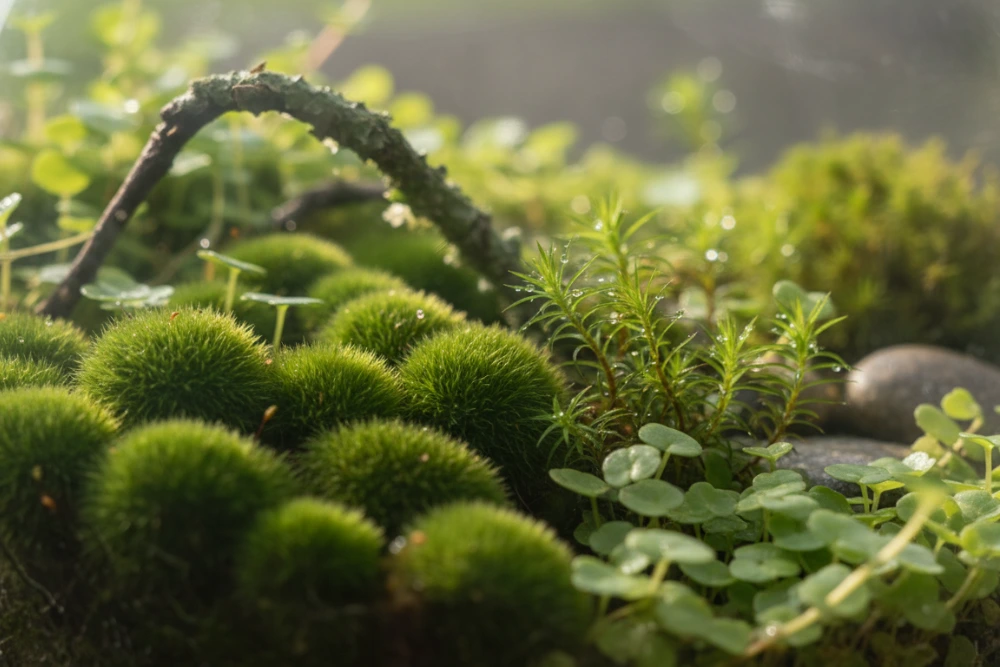
Care & Maintenance Tips
Ground covers prefer consistent moisture and partial shade. Mist gently two to three times a week, especially if your home heating dries the air. Avoid heavy watering; it can suffocate delicate roots and encourage mould.
If moss turns brown, the humidity is too low. Simply cover your terrarium briefly with plastic wrap or a lid to restore moisture levels. Trim the edges occasionally to keep spreading growth neat and contained.
13 Best Plants for Terrariums: Styling Ideas
Use Cushion Moss to form rolling mounds or hills, then weave Baby’s Tears or Selaginella apoda between larger roots and stones. Their bright green tones contrast beautifully against darker soil and bark.
For Americans who love natural, calming aesthetics, these low-lying greens add texture without clutter ideal for Zen-inspired designs or subtle home accents. They’re the quiet heroes that make a terrarium look complete.
8. Best Decorative or Statement Plants for Terrariums
Every terrarium deserves a focal point a plant that draws the eye and anchors the entire design. Moreover, it sets the tone for the rest of your arrangement, guiding how light, color, and texture interact inside the glass.
Furthermore, excellent statement choices include Ficus ginseng macrocarpa (Ficus Bonsai), Begonia spp., Asparagus plumosus (Asparagus Fern), Nephrolepis exaltata (Boston Fern), and Fittonia spp. (Nerve Plant). Additionally, each one adds depth, contrast, and natural charm to your miniature world, making it both balanced and alive.
Care & Maintenance Tips
Statement plants tend to grow faster or demand more space, so prune regularly to maintain proportion. Use sharp, sterilized scissors and remove any yellowing leaves immediately. Water sparingly but consistently about once every 7–10 days.
If you’re growing Begonia or Fittonia, mist lightly in the morning to avoid leaf spotting. Ficus ginseng prefers slightly drier soil between waterings, while ferns thrive in evenly moist conditions.
Styling Ideas
For a dramatic layout, place your statement plant slightly off-center rather than dead middle it feels more organic to the eye. Surround it with smaller, soft-textured species like Cushion Moss or Baby’s Tears to highlight contrast.
In American interiors, statement terrariums look fantastic on coffee tables and entryway consoles. Because they pair style with serenity, they instantly draw the eye and invite curiosity. So, combine natural wood bases or sleek black gravel for a modern contrast, letting your main plant stand proudly as the centerpiece of this tiny, living ecosystem.
13 Best Plants for Terrariums: Conclusion
Terrariums are about harmony, not perfection. The 13 Best Plants for Terrariums work together, each balancing light, moisture, and space. Whether it’s a humble Peperomia cutting or a dramatic Ficus bonsai, every plant adds to your ecosystem’s rhythm.
If you’re new, start with hardy species and simple containers. For example, learning about vibrant indoor varieties like growing Coleus plants indoors can inspire your terrarium choices and help you understand how color and texture bring life to small ecosystems.
Over time, you’ll learn to read your plants: drooping leaves, yellow fronds, or fogged glass all tell a story. Patience, observation, and gentle care are the true secrets to terrarium success.
FAQ:
What are the easiest terrarium plants for beginners?
Fittonia, Peperomia rotundifolia, and Soleirolia soleirolii are great starter plants. They handle humidity well and recover easily from small slips. So, even if you’re new to terrariums, these plants will still thrive beautifully and keep your little ecosystem healthy.
Can I use potting soil?
Regular soil holds too much water. Use a mix of sphagnum moss, perlite, and charcoal for drainage and air flow.
How often should I water?
Closed terrariums need watering every 2–3 weeks. Open ones need misting every few days. Watch condensation; it’s the best natural indicator.
Can I mix tropical and desert plants?
Avoid it. Tropical plants like humidity; cacti and succulents do not. Separate setups will keep both thriving.
What’s the best lighting for U.S. homes?
Moreover, north- or east-facing windows work best because they provide gentle, indirect sunlight that plants love. Additionally, in low-light regions, you can use LED grow lights for 8–10 hours daily. However, make sure the light isn’t too harsh, therefore keeping your terrarium balanced and healthy.
How do I prevent mold?
Trim overcrowded areas, add activated charcoal to soil, and open lids occasionally for airflow.

